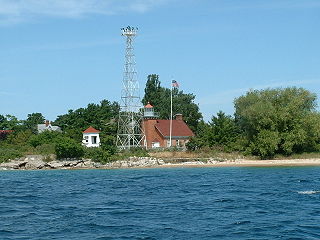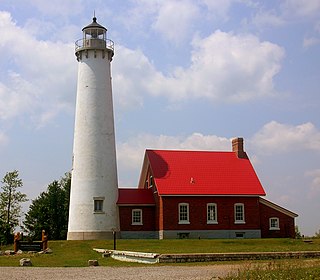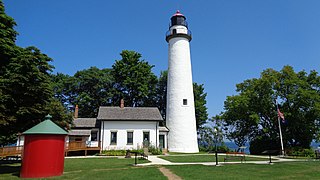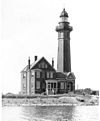
The Toronto Islands are a chain of 15 small islands in Lake Ontario, south of mainland Toronto, Ontario, Canada.

Cape Spear is a headland located on the Avalon Peninsula of Newfoundland near St. John's in the Canadian province of Newfoundland and Labrador. At a longitude of 52°37' W, it is the easternmost point in Canada and North America, excluding Greenland.

The Holland Harbor Light, known as Big Red, is located in Ottawa County, Michigan at the entrance of a channel connecting Lake Michigan with Lake Macatawa, and which gives access to the city of Holland, Michigan.

The Frankfort Light is a lighthouse located on the north breakwater in the harbor in Frankfort, Michigan. The current light was constructed in 1912 and placed on the National Register of Historic Places in 2005.

The Ludington Light is a 57-foot (17 m) tall steel-plated lighthouse in Ludington, Michigan, which lies along the eastern shores of Lake Michigan, at the end of the breakwater on the Pere Marquette Harbor. Given its location on the northern breakwater where the Pere Marquette River meets Lake Michigan, it is sometimes known as the Ludington North Breakwater Light. Underlying the building itself is a prow-like structure, which is designed to break waves.

The Little Traverse Light is located in Emmet County in the U.S. state of Michigan on the north side of the Little Traverse Bay of Lake Michigan on Harbor Point in West Traverse Township near Harbor Springs, Michigan. It marks the entrance to the harbor at Harbor Springs.

The Queen's Wharf Lighthouse is a lighthouse in Toronto, Ontario, Canada. It is situated at Fleet Street just east of the Princes' Gates at Exhibition Place. The octagonal building was originally part of a pair of lighthouses built in 1861 at Queen's Wharf, replacing an earlier 16-foot lighthouse built in 1838. The 11-metre (36-foot) three-storey wood structure is one of two surviving 19th-century lighthouses in Toronto.

Grand Traverse Light is a lighthouse in the U.S. state of Michigan, located at the tip of the Leelanau Peninsula, which separates Lake Michigan and Grand Traverse Bay. It marks the Manitou passage, where Lake Michigan elides into Grand Traverse Bay. In 1858, the present light was built, replacing a separate round tower built in 1852. The lighthouse is located inside Leelanau State Park, 8 miles (13 km) north of Northport, a town of about 650 people. This area, in the Michigan wine country, is commonly visited by tourists during the summer months.

A lighthouse keeper or lightkeeper is a person responsible for tending and caring for a lighthouse, particularly the light and lens in the days when oil lamps and clockwork mechanisms were used. Lighthouse keepers were sometimes referred to as "wickies" because of their job trimming the wicks.

The South Haven South Pierhead Light is a lighthouse in Michigan, at the entrance to the Black River on Lake Michigan. The station was lit in 1872, and is still operational. The tower is a shortened version of the Muskegon South Pierhead Light, and replaced an 1872 wooden tower. The catwalk is original and still links the tower to shore: it is one of only four that survive in the State of Michigan.

Forty Mile Point Light is a lighthouse in Presque Isle County near Hammond Bay on the western shore of Lake Huron in Rogers Township, Michigan USA.

The Beaver Head Light is located high on a bluff on the southern tip of Beaver Island. Boats trying to navigate North on Lake Michigan need to carefully work their way between Beaver Island and Gray's Reef.

The Ladies Delight Light is a small lighthouse on Cobbosseecontee Lake, in Winthrop, Maine, United States. It was constructed in 1908 and is believed to be the only active inland waters lighthouse in Maine. The tower is 25 feet (7.6 m) tall, and is equipped with a 100-watt light bulb further intensified by a lens from a ship's anchor light. At the time of its construction, it was the only inland lake lighthouse east of the Mississippi River. It was listed on the National Register of Historic Places in 1984.

The Manistee Pierhead lights are a pair of active aids to navigation located on the north and south pier in the harbor of Manistee, Michigan, "Lake Michigan’s Victorian Port City."

Sambro Island Lighthouse is a landfall lighthouse located at the entrance to Halifax Harbour, Nova Scotia, on an island near the community of Sambro in the Halifax Regional Municipality. It is the oldest surviving lighthouse in North America and its construction is a National Historic Event.

The Toronto Harbour Light is an automated lighthouse at Vicki Keith Point on the Leslie Street Spit in Toronto, Ontario, Canada.

Tawas Point Light is located in the Tawas Point State Park off Tawas Bay in Lake Huron in Baldwin Township in Northern Michigan.

Pointe aux Barques Lighthouse is an active lighthouse located in Huron County in the U.S. state of Michigan. It is located along the shores of Lake Huron on the northeastern tip of the Thumb. Originally constructed in 1848, it is one of the oldest active lighthouses in the state. The name is translated as "point of little boats" from the French language, which refers to the shallow coastline that poses a threat to larger boats.
The Glengarry Light Infantry Fencibles were a light infantry unit, raised chiefly in the Glengarry District of Upper Canada shortly before the outbreak of the Anglo-American War of 1812. The unit fought throughout the war, and was disbanded shortly afterwards.






















